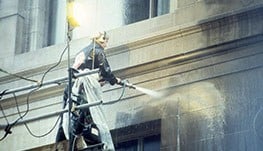Sodium Bicarbonate: The Softer Blasting Abrasive
Featured Product from Church & Dwight, Inc. Specialty Products Division

It is sometimes said that necessity is the mother of invention. And so it was with sodium bicarbonate's discovery as a gentle abrasive suitable for cleaning materials of coatings and contaminants without damaging the underlying substrate.
In the mid-1980s, engineers restoring the Statue of Liberty required a method of removing layers of coal tar epoxy from the interior of the statue without damaging its copper plating. ARMEX™ baking soda was successfully used to strip away these layers without harming the metal's structural integrity. An industry was born that would soon find applications in restoration, remanufacturing, industrial cleaning and cleaning food industry machinery, among many others applications.
Sodium bicarbonate's use as a soft but effective cleansing agent stems from its inherent softness compared with most other abrasive materials. Baking soda rates 2.5 on the Mohs scale of hardness—just above talc and well below traditional blasting abrasives such as silica sand, mineral slags, and glass beads.
Delivered under relatively low pressure, but high velocity, specially formulated sodium bicarbonate crystals shatter upon impact, delivering their energy along the substrate rather than into it. This action enables paint, dirt, grease, burnt on carbon and contaminants to be removed efficiently without damaging the material beneath it.
ARMEX has developed 11 sodium bicarbonate formulas, with mean particle sizes ranging from 70 microns (220 grit) to 270 microns (70 grit). Broadly, these formulations fall into three categories:
- Larger-sized particles yield more penetrating power, making these ("XL") formulas appropriate for thicker coating removal and heavier cleaning applications.
- Medium-sized particles are suited to thinner coatings on more sensitive substrates, such as wood or aluminum, as they carry less mass but deliver more hits per square inch to the material being cleaned.
- Smaller particles are used in specialty formulas for very specific surface preparation requirements, as well as for highly sensitive, thin, or composite materials with light coatings.
Harder abrasives, such as sand, mineral slags, and steel shot or grit, generally remain intact as they impact the substrate, which can result in pitting, tearing, etching, erosion, and other damage to the material's surface. The frontal impact of such abrasives can also generate heat that can lead to warping of the substrate. Click here to read entire article









